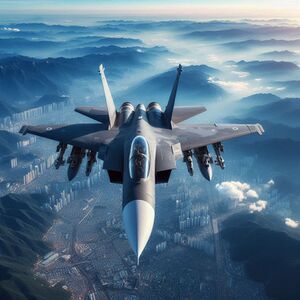KEA-120 Starling
| KEA-120 Starling | |
|---|---|

| |
| KEA-120 Starling flies over Daejeon Metropolitan City. | |
| Role | Electronic warfare aircraft |
| National origin | |
| Manufacturer | Daesung Aerospace,. Inc. |
| First flight | 2 March 2012 |
| Introduction | 12 October 2014 |
| Status | In service |
| Primary user | Royal Joseon Air Force Royal Joseon Navy |
| Produced | 2012-2020 |
The KEA-120 Starling is a land runway-based/carrier-based electronic warfare aircraft, a specialized version of the two-seat KF-20 Chamsuri. The KEA-120 was developed as an aircraft to replace the KEA-102 and was produced by 2020. Currently, the KEA-120 is the only escort jammer aircraft of the Royal Joseon Armed Forces.
The KEA-120 is primarily tasked with jamming enemy radars and air defense systems, as well as enemy aircraft's radars and electronic equipment. If necessary, the KEA-120 can use AGM-88 anti-radar missiles and AIM-120 air-to-air missiles to engage directly with enemy radar facilities or enemy aircraft.
The KEA-120 is designed to be operational on ground runways and CATOBAR aircraft carriers. Since the KEA-120 is designed based on the KF-20, it shares many features with the KF-20.
Development
In 2005, the Royal Joseon Armed Forces approved a development plan for a new aircraft with higher viability, combat capability, flight performance, and electronic warfare capabilities compared to KEA-102, an extremely aging previous generation aircraft. Daesung Aerospace, the main contractor, began developing electronic warfare aircraft based on the then-developing KF-20 Chamsuri fighter jet.
It took seven years for the first prototype aircraft to succeed in flying. However, the prototype aircraft met the military's required performance, and the Ministry of Defense approved a large order for the KEA-120 and allocated the relevant budget. A total of 360 KEA-120 were produced from 2012 to 2020.
Design
Electronic warfare systems
- AN/ALQ-1002
The AN/ALQ-1002 is an airborne passive Radar warning receiver / electronic warfare support measures / electronic signals intelligence (RWR/ESM/ELINT) sensor system designed for airborne situational awareness and signal intelligence gathering. The AN/ALQ-1002 detects, identifies, locates and analyzes sources of radio frequency emission.
- AN/ALQ-1001
The AN/ALQ-1001 is an airborne integrated jamming system designed and manufactured by Miltech corporation. Receiver equipment and antennas are mounted in a fin-tip pod while jamming transmitters and exciter equipment are located in under-wing pods. The system is capable of intercepting, automatically processing and jamming received radio frequency signals. The system receivers can also be used to detect, identify and direction find those signals, providing signals intelligence (SIGINT) either automatically or manually.
The AN/ALQ-1001 can jam frequencies in various bands. Jamming frequency ranges are set forth in 10 bands.
- List of Bands
- Band 1: 64 - 150 MHz
- Band 2: 150 - 270 MHz
- Band 3: 270 - 500 MHz
- Band 4: 0.5 - 1 GHz
- Band 5/6: 1 - 1.25 GHz
- Band 7: 2.5 - 4 GHz
- Band 8: 4 - 7.8 GHz
- Band 9: 7.8 - 11 GHz
- Band 10: 11 - 20 GHz
The KEA-120 can be equipped with up to five AN/ALQ-1001 jamming pods and will typically add two AIM-120 AMRAAM or AGM-88 HARM missiles. The KEA-120 will also use the INCANS Interference Cancellation system that will allow voice communication while jamming enemy communications. In addition to the radar warning and jamming equipment, the KEA-120 possesses a communications receiver and jamming system that will provide suppression and electronic attack against airborne communication threats.
Radar signature reduction measures
The KEA-120 has applied several stealth designs to reduce the RCS(Radar cross-section), even though it is classified as a non-stealth aircraft, a 4.5th generation fighter. The KEA-120 is designed to allow the vertical stabilizers to have a certain level of inclination, ensuring stealth capabilities on some aspects of the aircraft. The design of the engine inlets reduces the KEA-120's frontal RCS. The alignment of the leading edges of the engine inlets is designed to scatter radiation to the sides. Fixed fanlike reflecting structures in the inlet tunnel divert radar energy away from the rotating fan blades. The KEA-120 also makes considerable use of panel joint serration and edge alignment to direct reflected waves away from the aircraft in uniformly narrow angles. Considerable attention is paid to the removal or filling of unnecessary surface join gaps and resonant cavities. The KEA-120 has a frontal RCS an order of magnitude smaller than prior generation fighters.